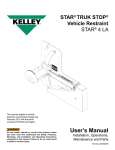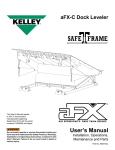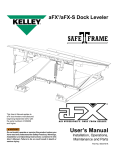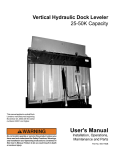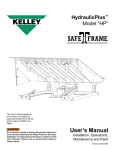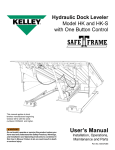Download User`s Manual - Curlin, Inc.
Transcript
stAR® Truk stop® Vehicle Restraint STAR® 1 This manual applies to vehicle restraints manufactured beginning February 2013 with the serial numbers 61070042 and higher. Do not install, operate or service this product unless you have read and understand the Safety Practices, Warnings, and Installation and Operating Instructions contained in this manual. Failure to do so could result in death or serious injury. User’s Manual Installation, Operations, Maintenance and Parts Part No. 5343 R18 Table of contents Introduction..................................................................2 Safety Signal Words....................................................2 Safety Practices..........................................................3 Installation...................................................................4 Mounting Considerations........................................4 Tools Required........................................................4 Wedge Anchor Installation (Std. Installation)..........5 Installation with Pit Type Dock Levelers..................6 Installation with EOD Type Dock Levelers..............9 Optional Snow Plow Guard Placement...................9 Operation...................................................................10 Operational Checks...................................................11 Parts Replacement Instructions ...............................12 Subframe Reinforcing Kit..........................................13 Parts List...................................................................14 Pivot Pin Guard Kit Installation Instructions..............16 Warranty Information.................................................19 Distributor Information...............................................20 Introduction Welcome, and thank you for buying your vehicle restraint from Kelley®. This User’s Manual contains information that you need to safely install, operate and maintain the vehicle restraint. It also contains a complete parts list and information about ordering replacement parts. Please keep and read this User’s Manual before using your new vehicle restraint. Safety SIGNAL WORDS You may find safety signal words such as DANGER, WARNING, CAUTION or NOTICE throughout this Owner’s Manual. Their use is explained below: This is the safety alert symbol. It is used to alert you to potential personal injury hazards. Obey all safety messages that follow this symbol to avoid possible death or injury. Indicates an imminently hazardous situation which, if not avoided, will result in death or serious injury. Indicates a potentially hazardous situation which, if not avoided may result in minor or moderate injury. Indicates a potentially hazardous situation which, if not avoided, could result in death or serious injury. Notice is used to address practices not related to personal injury. 2 ©2013 4Front Engineered Solutions, Inc. 5343 R18 — STAR® 1 Vehicle Restraint February 2013 Safety practices INSTALLATION, MAINTENANCE AND SERVICE Read these safety practices before installing, operating or servicing the vehicle restraint. Failure to follow these safety practices could result in death or serious injury. READ AND FOLLOW THE OPERATING INSTRUCTIONS IN THIS MANUAL BEFORE OPERATING THE VEHICLE RESTRAINT. If you do not understand the instructions, ask your supervisor to teach you how to use the vehicle restraint. Improper installation of vehicle restraint could result in death or serious injury to dock workers or other users of the vehicle restraint. Be certain to follow the installation instructions in this manual. OPERATION Use by untrained people can cause property damage, bodily injury and/or death. Your supervisor should teach you the safe and proper way to use the vehicle restraint. Read and follow the complete OPERATION PROCEDURE on page 6 before use. DO NOT USE THE VEHICLE RESTRAINT IF IT IS NOT WORKING RIGHT. Tell your supervisor it needs repair. If the vehicle restraint does not operate properly using the procedures in this manual, BE CERTAIN TO CHOCK THE VEHICLE WHEELS BEFORE LOADING OR UNLOADING. Call your local Kelley® distributor for service. Place barricades around pit on dock floor and drive while installing, maintaining or repairing trailer restraining device. Do not stand in the driveway between the dock and a backing vehicle. Do not use the vehicle restraint as a step. Do not install the vehicle restraint anchor bolts into aged or unsound concrete. Keep hands and feet clear of guide tracks and moving parts at all times. Do not weld on ductile iron hook casting (item 2, page 10). If you have any problems or questions, contact your local Kelley distributor for assistance.v Be certain bystanders in the driveway stand clear when vehicle restraint is operated. Do not load or unload any vehicle unless you make certain the vehicle restraint has securely hitched the vehicle's Rear Impact Guard (RIG) and set the brakes. If the vehicle restraint does not hitch the vehicle's RIG for any reason, BE CERTAIN TO CHOCK THE VEHICLE WHEELS BEFORE LOADING OR UNLOADING. Before chocking wheels or engaging vehicle restraint, dump air from air ride suspensions and set parking brakes. February 2013 5343 R18 — STAR® 1 Vehicle Restraint ©2013 4Front Engineered Solutions, Inc. 3 Installation Mounting considerations Before installation read and follow the Safety Practices on page 3. Failure to follow these safety practices could result in death or serious injury. READ AND FOLLOW THE OPERATION INSTRUCTIONS IN THIS MANUAL BEFORE OPERATING THE VEHICLE RESTRAINT. If you do not understand the instructions, ask your supervisor to teach you how to use the vehicle restraint. Improper installation of the vehicle restraint could result in death or serious injury to dock workers or other users of the vehicle restraint. Place barricades around pit on dock floor and drive while installing, maintaining or repairing vehicle restraining device. Be certain bystanders in the driveway stand clear when vehicle restraint is operated. Be certain to follow the installation instructions in this manual. 3. Docks 46" and lower may require a specially modified vehicle restraint or operation of the dock leveler may need to be restricted. Contact your local Kelley distributor for information. 4. A 3/8" gap is required between the dock leveler front angle and pit floor to install the horizontal mounting plate. If the driveway beneath the vehicle restraint is affected by frost heave: 1. Raise restraint sufficient distance to prevent damage, or 2. Modify driveway to provide additional clearance. Consult registered architect or professional engineer. Tools required - Welder - Impact or rotary drill with 1/2" diameter concrete drill bit - 9/16" wrench - General hand tools - Touch up paint (Gold) - Torque wrench (45 ft-lb min.) - Rebar cutting drill bit with rotary only drill motor. Do not install the vehicle restraint anchor bolts into aged or unsound concrete. 1. The dock face on which the vehicle restraint will be mounted must be flat to prevent binding of the mechanism. If the dock face is not flat it may be necessary to use shims or physically modify the dock face to provide a flat mounting surface. If shimming is required it is necessary to shim behind the pivot pin as well as at the anchor bolts. Vehicle restraints require a 4" - 5" bumper projection from the front of the bumper to the rear of the back plate of the restraint (the mounting surface). Less than 4" of projection can allow vehicle RIG to damage the restraint. Some lip saddle type dock levelers may require modifications. Consult the factory. 2. The standard anchors provided with this product may only be used on docks constructed of solid concrete. For mounting to block walls refer to Service Bulletin #1023. Docks constructed with other materials require special mounting consideration. Contact your local Kelley distributor for information. 4 ©2013 4Front Engineered Solutions, Inc. 5343 R18 — STAR® 1 Vehicle Restraint February 2013 Installation, continued Wedge anchor installation (standard installation) Fig. 1 Do not install the vehicle restraint anchor bolts into aged or unsound concrete. Use standard anchors on smooth 4,000 psi concrete walls only. For aggregate, cinder block or tilt walls consult factory. Oversized holes in the base material will make it difficult to set the anchor and will reduce the anchor’s load capacity. Do not use an impact wrench to set or tighten the wedge anchors. 1. Using a 1/2" diameter bit, drill a hole into the base material to a depth of at least 1/2" deeper than the embedment. The minimum embed depth of the 1/2" anchor is 3-3/8". The tolerances of the drill bit should meet the requirements of ANSI Std. B212.15. 2. Blow the hole clean of dust and other material. Do not expand the anchor or screw the bolt in the anchor assembly prior to installation. 3. Drive the anchor through the fixture into the anchor hole until the bolt head is firmly seated against the fixture. Be sure the anchor attains the minimum embed depth of 3-3/8". 4. Tighten the anchor by applying 40 ft. lbs. torque. See Fig 1. February 2013 5343 R18 — STAR® 1 Vehicle Restraint ©2013 4Front Engineered Solutions, Inc. 5 Installation, continued Installation with pit type dock levelers Fig. 2 Do not install, operate or service this product unless you have read and followed the Safety Practices, Warnings, and Installation and Operation Instructions in this manual. Failure to do so could result in death or serious injury. ALWAYS USE THE DOCK LEVELER SUPPORT WHEN WORKING UNDER A DOCK LEVELER RAMP OR LIP. Centerline of dock leveler Horizontal mounting plate Place barricades around pit on dock floor and drive while installing, maintaining or repairing dock leveler or vehicle restraint. Improper installation of anchoring devices or installation into aged or unsound concrete could result in death or serious injury. Inadequate lifting equipment or practices can cause a load to fall unexpectedly. Make sure the lifting chain or other lifting devices are in good condition and have a rated capacity of at least 500 lbs for the lifting angle used. Never allow anyone to stand on or near the restraint when it is lifted or positioned. Stand clear of vehicle restraint when it is positioned. Failure to follow this warning can allow the restraint to fall, tip, or swing into people, causing death or serious injury. 10" Dock leveler front angle Centerline of horizontal mounting plate Fig. 3 Centerline of dock leveler Dock leveler front angle Horizontal mounting plate 1. Insert the horizontal mounting plate into the gap between the dock leveler front angle and the pit floor. NOTE: For the Kelley Mechanical “MK” model dock levelers and Kelley 60,000 pound capacity hydraulic dock levelers, the mounting plate must be mounted to the left of the dock leveler centerline as shown in Fig. 2. This off-center mounting is to allow for dock leveler spring adjustment and to prevent interference with lip rod lugs. For other dock levelers the horizontal mounting plate may be centered with the dock leveler. See Fig. 3. If the horizontal mounting plate cannot be used, the top portion of the vehicle restraint must be welded to the dock leveler front angle and additional anchor plates installed to fasten the dock leveler subframe securely to the pit floor. A dock leveler reinforcing kit Kelley Part Number (P/N) 901-323 is available for this purpose. Recommended reinforcing is illustrated on page 13. Centerline of horizontal mounting plate Fig. 4 Dock leveler front angle Vehicle restraint Horizontal mounting plate Suggested anchor holes 2. Check access to the horizontal mounting plate anchor holes. A minimum of four (4) anchor holes spaced across the plate must be accessible. Drill additional 9/16" diameter anchor holes through the mounting plate if required. See Fig. 4. 6 ©2013 4Front Engineered Solutions, Inc. 5343 R18 — STAR® 1 Vehicle Restraint February 2013 Installation, continued 3. Place the bottom edge of vehicle restraint 1/2" above the driveway and align the backplate with the horizontal mounting plate. See Fig. 5. If the driveway is affected by heaving from frost, follow NOTICE on page 4 to prevent damage from the driveway movement. 4. Tack weld the vehicle restraint to the horizontal mounting plate using the tabs on the front of the plate. See Fig. 5. Fig. 5 7. Before anchoring vehicle restraint, operate the dock leveler with the vehicle restraint in its intended mounting position. Check that the vehicle restraint does not interfere with below dock operation and that the pendant dock leveler lip does not support the weight of the dock leveler on any part of the vehicle restraint. Operate in the below dock and dock level end load position with the lip pendant and with the lip extended. Store the dock leveler several times to be sure the pendant lip does not come to rest supporting the weight of the dock leveler on the vehicle restraint. Readjust mounting position as required. The vehicle restraint may be moved such that the horizontal mounting plate is up to 12" off center. Improper installation that allows the pendant dock leveler lip to support the weight of the dock leveler could result in death or serious injury. It is sometimes necessary to install lip deflector plates as indicated in Fig. 7 to avoid any chance of the pendant lip storing on top of or behind the backplate. Materials supplied by installer. Dock face Fig. 6 Fig. 7 1/4" Fillet weld top side, full width of back plate. paint after welding. Add lip deflector plates if required Install anchors in min. of six (6) mounting holes Shim between back plate and face of dock if back plate is not plumb and flush with dock face. Weld shims in place. Fig. 8 Dock leveler front angle 8. Anchor the back plate to the dock face using the anchors provided. The anchor bolts must be torqued to 40 ft-lbs to achieve maximum holding strength. See Fig. 7 and wedge anchor installation instructions on page 5. February 2013 Dock leveler front angle Butt weld mounting plate tabs to back plate 5. Pull the vehicle restraint and mounting plate away from the dock and weld the full width of the horizontal mounting plate with a 1/4" fillet weld on the top side. Paint welded area to prevent rust. See Fig. 6. 6. Slide the Vehicle Restraint/Mounting Plate assembly back into position on the dock. See Step 1, page 6 for location. If shimming is required it is necessary to shim behind the pivot pin as well as at the anchor bolts. The pivot pin is shimmed to prevent bending the back plate if the pivot area is struck. The pivot pin area must not be fastened but left free to float. Back plate 5343 R18 — STAR® 1 Vehicle Restraint Backplate Horizontal mounting plate Suggested anchor holes ©2013 4Front Engineered Solutions, Inc. 7 Installation, continued Fig. 9 Mount sign on right side of door opening (vehicle driver’s side). “Back in or pull out with hook down only”. Improper installation of anchoring devices or installation into aged or unsound concrete could result in death or serious injury. Anchors must be installed in a minimum of six (6) back plate mounting holes. The anchor bolts should be installed as the holes are drilled to prevent the vehicle restraint from shifting. The anchor bolt heads must be tight against the back plate to prevent interference with the hook arm and gas spring. 9. Anchor the horizontal mounting plate to the pit floor using the concrete anchors provided with the vehicle restraint. The anchor bolts must be torqued to 40 ft-lbs to achieve maximum holding strength. A minimum of (4) anchors across the plate must be used. See Fig. 8 and wedge anchor installation instructions on page 5. 10. Move the hook up and down to be certain the hook does not contact the track. Washers on the pivot pin may be moved from front to rear or vice versa to shim hook in or out as required. See “PARTS REPLACEMENT INSTRUCTIONS - Hook and Gas Spring” on page 9 for instructions on how to remove the hook to gain access to the rear shim washers. Approx. 8 Ft. Fig. 10 Pushbar hanger bracket Mount dock workers instruction sign on left side of door or door jamb Pushbar MOUNTING HARDWARE PROVIDED BY OTHERS Fig. 11 Centerline of dock leveler and stand-off Pin support 11. Permanently mount the “Back In or Pull Out with Hook Down Only” sign on the outside of the building. See Fig. 9. Stand-off 10" 12. Permanently mount the dock workers instruction sign to the inside building wall. See Fig. 10. 13. Mount the pushbar hanger bracket to the inside building wall. See Fig. 10. 14. Operate the vehicle restraint per the Operation instructions on page 10. Check for smooth operation and positive latching in the latched position. 15. Install pivot pin guard per instructions on page 16. 16. Instruct the dock workers on how to use the vehicle restraint using the instructions on page 10. Approx. 4 Ft. 5-3/4" 10" Fig. 12 (10) 1/2-13 x 1-1/2" Capscrews, (10) 1/2 -13 Locknuts, (20) 1/2 Flat washers (Supplied by others.) Stand-off Vehicle restraint MOUNTING HARDWARE SUPPLIED BY OTHERS 8 ©2013 4Front Engineered Solutions, Inc. 5343 R18 — STAR® 1 Vehicle Restraint February 2013 Installation, continued Installation with eod type dock levelers and loadhog dock bridges Fig. 13 Do not install, operate or service this product unless you have read and followed the Safety Practices, Warnings, and Installation and Operation Instructions in this manual. Failure to do so could result in death or serious injury. ALWAYS USE THE DOCK LEVELER SUPPORT WHEN WORKING UNDER A DOCK LEVELER RAMP OR LIP. Lip deflector Inadequate lifting equipment or practices can cause a load to fall unexpectedly. Make sure the lifting chain or other lifting devices are in good condition and have a rated capacity of at least 500 lbs for the lifting angle used. Never allow anyone to stand on or near the restraint when it is lifted or positioned. Stand clear of vehicle restraint when it is positioned. Failure to follow this warning can allow the restraint to fall, tip, or swing into people, causing death or serious injury. Improper installation of anchoring devices or installation into aged or unsound concrete could result in death or serious injury. Place barricades around pit on dock floor and drive while installing, maintaining or repairing trailer restraining device. Fig. 14 1. Position the stand-off so that it is centered on the dock face in front of the dock leveler. See Fig. 11. 9" 18" 2. Place the bottom edge of vehicle restraint 1/2" above the driveway. Anchor the stand-off to the dock face using the 10 anchors provided. The anchors must be torqued to 40 ft-lbs to achieve maximum holding strength. See wedge anchor installation instructions on page 5. 3. Position and anchor the pin support using four (4) anchor fasteners. See Fig. 11. The pin support is used to prevent bending of the back plate if the pin area is struck. The pivot pin area must not be fastened but left free to float. 48" Concrete filled posts PLAN VIEW Fig. 15 Dock face Vehicle restraint 4. Bolt the vehicle restraint to the stand-off. See Fig. 12. 5. Bolt the lip deflector (if supplied) to the STAR lip deflector using 5/8-11 x 2" bolt and nut. See Fig. 13. 6. Follow applicable instructions 10 through 15 on page 8 for remaining installation. 9" Driveway 9" Concrete filled posts FRONT VIEW Optional snow plow guard placement If desired, install concrete filled posts for protection from damage that may be caused by snow removal equipment. See Fig. 14 and 15 for suggested placement. February 2013 5343 R18 — STAR® 1 Vehicle Restraint ©2013 4Front Engineered Solutions, Inc. 9 Operation Fig. 16 Before operating the vehicle restraining device, read and follow the Safety Practices, Warnings, and Operation instructions contained in this manual. Use by untrained people could result in death or serious injury. Push bar Do not load or unload any vehicle unless you make certain the vehicle restraint has securely hitched the vehicle's RIG and set the brakes. If the vehicle restraint does not hitch the vehicle's RIG for any reason, BE CERTAIN TO CHOCK THE VEHICLE WHEELS BEFORE LOADING OR UNLOADING. Enter the vehicle only when the green signal light on the control box is on. You must check the green signal light each time that the vehicle is entered. If the green light goes off at any time during loading operations, immediately cease loading operations and check the vehicle restraint to ensure that it is securely hitched. If power to the vehicle restraint is interrupted, immediately cease operations and check the unit. Vehicles leaving or moving when loading and unloading are in process could result in death or serious injury. Latch lever Hook Fig. 17 Push bar Hook Failure to place the hook in the stored position when not in use could result in damage to the vehicle restraint and incoming vehicles. Be certain bystanders in the driveway stand clear when the vehicle restraint is operated. To hitch vehicle 1. Position vehicle against dock bumpers and set brakes. 2. Using the pushbar supplied with the vehicle restraint, push down the latch lever. The hook will rise and hitch the vehicle RIG. See Fig. 16. 3. Make certain that the hook has hitched the vehicle RIG. If the RIG is not hitched or the vehicle does not have an RIG, chock the vehicle wheels before loading or unloading. To release vehicle 1. When loading or unloading is complete, use the pushbar to push the hook to the latched position at the bottom of the track. See Fig. 17. The hook will automatically latch. 2. Tell the vehicle driver “Your vehicle may now pull away from the dock.” 4. Tell the vehicle driver “Your vehicle must stay at the dock.” 5. After the vehicle RIG is hitched, or the wheels are chocked, you may load or unload the vehicle. 10 ©2013 4Front Engineered Solutions, Inc. 5343 R18 — STAR® 1 Vehicle Restraint February 2013 Operational checks Do not service this product unless you have read and followed the Safety Practices, Warnings, and Operation instructions contained in this manual. Failure to follow these safety practices could result in death or serious injury. Daily Operate the vehicle restraint to assure that it operates smoothly and that the hook moves freely along the entire length of track, and positively latches in the stored position per the Operation instructions, page 10. Weekly Inspect the vehicle restraint for damage which may weaken the anchoring strength. Retighten the concrete anchors if necessary. (40 ft-lbs.) Monthly Check all operating, warning, caution labels, and signs to be sure they can be read. Replace them if required. See the Parts List on page 14, for part numbers. QUARTERLy Inspect dock bumpers. 4" of protection is required. Worn, torn, or missing bumpers must be replaced. February 2013 5343 R18 — STAR® 1 Vehicle Restraint ©2013 4Front Engineered Solutions, Inc. 11 PARTS REPLACEMENT INSTRUCTIONS Fig. 18 Do not service this product unless you have read and followed the Safety Practices, Warnings, and Operation instructions contained in this manual. Failure to follow these safety practices could result in death or serious injury. Spring Lever Place barricades around pit on dock floor and drive while installing, maintaining or repairing trailer restraining device. Latch mechanism – fig. 18 3/8-16 X 3-1/2" Capscrew 1. Release hook by pressing down the latch lever. 2. Remove three (3) 3/8-16 x 3-1/2" capscrews. Fig. 19 Spring pin 3. Carefully remove pretensioned spring. 4. Slide lever off of mounting pin. Hook arm and gas spring – fig. 19 1. Release hook by pressing down the latch lever. Latch lever Klipring 2. Hold hook partially down and drive the top spring pin through the track. 3. Slowly release the hook arm to allow the gas spring to fully extend. 4. SUPPORT THE HOOK SO THAT IT DOES NOT FALL WHEN THE GAS SPRING IS REMOVED. Remove clips on gas spring ball studs. Carefully pry the gas spring off of the ball stud on each end of the gas spring. Gas spring 5. Remove the klipring from the pivot pin. 6. With the hook arm in the highest position, slide the arm off of the pin. 7. Reverse above sequence to replace parts. Lubricate the ball studs and pivot pin before reassembly. 12 ©2013 4Front Engineered Solutions, Inc. 5343 R18 — STAR® 1 Vehicle Restraint February 2013 Subframe reinforcing kit Fig. 20 Weld bracket here and anchor to pit floor Do not install this product unless you have read and followed the Safety Practices, Warnings, and Operation instructions contained in this manual. Failure to follow these safety practices could result in death or serious injury. SUBFRAME REINFORCING KIT Use the Dock Leveler Reinforcing Kit P/N 901-323 when a horizontal mounting plate cannot be used to anchor the top of the vehicle restraint. This kit provides brackets that can be used to securely anchor the dock leveler to the pit so that the vehicle restraint can be anchored to the dock leveler. See Fig. 20, 21 and 22. Reinforcing bracket one on each side of power pack Fig. 21 Reinforcing brackets welding on and anchored to pit floor Weld reinforcing bars between the back of the vehicle restraint back plate and the front of the subframe front angle. Reinforcing bars provided by the installer. See Fig. 23. For dock levelers with angled front angles, reinforce as shown in Fig. 24. Locate horizontal mounting plate and vehicle restraint as shown in Fig. 2 or 3, page 6. Anchor horizontal mounting plate to pit floor per Fig. 4, page 6. Fig. 22 Reinforcing brackets welding on and anchored to pit floor Fig. 23 Subframe front angle Reinforcing bar Back plate Fig. 24 3/4" dia. rod, 14" lg. - weld to front angle and back plate. rod supplied by others. Remove tabs from horizontal mounting plate and weld to front angle Back plate Dock leveler subframe front angle February 2013 5343 R18 — STAR® 1 Vehicle Restraint Front pit curb angle ©2013 4Front Engineered Solutions, Inc. 13 Parts list Fig. 25 17 10 20 23 19 1 12 16 12 11 13 25 3 3 22 2 10 8 6 7 25 5 13 14 27 21 4 21 9 26 24 15 18 14 ©2013 4Front Engineered Solutions, Inc. To ensure proper function, durability and safety of the product, only replacement parts that do not interfere with the safe, normal operation of the product must be used. Incorporation of replacement parts or modifications that weaken the structural integrity of the product, or in any way alter the product from its normal working condition at the time of purchase from KELLEY could result in product malfunction, breakdown, premature wear, death or serious injury. 5343 R18 — STAR® 1 Vehicle Restraint February 2013 Parts list, continued Item Quantity DescriptionPart Number 1 1 Back Plate Weldment - Plated 713-397 2 1 Hook Arm, Machined - Plated 675-411 3 2 Bearing, Ball (Included in Item 2) 091-097 4 1 Latch Arm Guard Weldment - Plated *713-024 5 1 Release Lever Weldment - Plated *713-023 6 1 Spring, Extension *101-077 7 1 Bearing, Cylindrical 1/2" x 5/8" x 1" *091-095 8 1 Ring, Retaining 1 /2" *131-351 9 3 Capscrew, Hex Hd 3/8" - 16 x 3-1/2" lg *131-364 10 2 Pin, Roll 1/2" dia x 1-1/4" lg 035-100 11 1 Gas Spring 709-472 12 2 Rod End (included in item 11) 708-829 13 A/R Washer 1-1/2" OD x 1-1/16" ID 000-064 14 1 Klipring, 1" 049-064 15 1 Label “Warning Stand Clear” 708-778 16 1 Serial tag 6009761 17 1 Horizontal Mounting Plate - Green Paint 709-470 18 1 Pushbar 708-736 19 1 Sign, Vehicle Driver Information 708-744 20 1 Sign, Dock Workers Information 708-779 21 2 Bearing, Flanged 22 1 pkg. 23 *091-094 Anchors, 14 per package (not shown) 287-510 1 Label, STAR TRUK STOP Logo 709-624 24 1 Hanger Bracket 152-814 25 2 Ring, Retaining (Included in Item 2) 049-067 26 1 Latch Assembly - Plated 713-025 27 1 Grease Fitting (Used for item 5) ® ® *127-002 * Included in Item 26 February 2013 5343 R18 — STAR® 1 Vehicle Restraint ©2013 4Front Engineered Solutions, Inc. 15 Kit instructions Installation Instructions 1. Place hook in the down position. 2. Located Item 1 directly above the existing pin guard. (See Fig. 26.) with its bottom edge aligned as shown in detail 'A'. 3. Using Item 1 as a template drill four 1/2" dia. x 3-1/2" deep mounting holes. 4. Fasten Item 1 to the dock face using the 4 anchor bolts (two anchor bolt if welding) torqued to 40 ft-lbs. See Wedge Anchor installation instructions on page 5. 5. Grind smooth the mating surfaces of Item 1 and existing pin guard. Repaint this area and any welds to prevent rust. Curb angle 1 NOTE: To Eliminate drilling through the curb angle, weld the upper end of the pin guard to the curb angle as noted below. Do not weld Item 1 to the existing pin guard. This area of the restraint must be free to move. Torque to 40 Ft. LBS. 2 Grind smooth if required to assure no catch point Fig. 26 Installation instructions auxiliary pivot pin guard for Star Truk Restraints Part No. 908-854 View ‘A - A’ 1/4" (Centered) 1 Existing pin guard Detail ‘A’ (Do not weld at Detail ‘A’) Curb angle ‘A’ 1 Note: Weld here as shown if upper anchor bolt is not used. Lower anchors bolt must be used Existing pin guard ‘A’ Item Quantity DescriptionPart Number 1 1 Guard, Pivot Pin 712-634 2 4 Anchor Bolt, 1/2 x 3-1/2 131-260 16 ©2013 4Front Engineered Solutions, Inc. 5343 R18 — STAR® 1 Vehicle Restraint February 2013 Notes February 2013 5343 R18 — STAR® 1 Vehicle Restraint ©2013 4Front Engineered Solutions, Inc. 17 Notes 18 ©2013 4Front Engineered Solutions, Inc. 5343 R18 — STAR® 1 Vehicle Restraint February 2013 warranty Base Limited Warranty: 4Front Engineered Solutions, Inc. warrants that this VEHICLE RESTRAINT will be free from defects in material and workmanship under normal use for a period of one (1) year from the earlier of 1) 60 days after the date of initial shipment by 4Front Engineered Solutions, Inc., or 2) the date of installation of the VEHICLE RESTRAINT by the original purchaser, provided that the owner maintains and operates the VEHICLE RESTRAINT in accordance with this Owner's Manual. In the event that this VEHICLE RESTRAINT proves defective in material or workmanship within the applicable warranty period, 4Front Engineered Solutions, Inc. will, at its option: 1. Replace the VEHICLE RESTRAINT, or the defective portion of either, without charge to the owner; or 2. Alter or repair the VEHICLE RESTRAINT, on site or elsewhere, without charge to the owner. The limited warranty stated in the preceding paragraph IS EXCLUSIVE AND IT IS IN LIEU OF ANY OTHER GUARANTEES AND WARRANTIES, EXPRESS OR IMPLIED. The warranty does not cover any failure caused by improper installation, abuse, negligence, or failure to maintain and adjust the VEHICLE RESTRAINT properly. Parts requiring replacement due to damage resulting from vehicle impact, abuse, or improper operation are not covered by this warranty. 4Front Engineered Solutions, Inc. disclaims any responsibility or liability for any loss or damage (including, without limitation, direct, indirect or consequential damages, or lost profits or production time) that results from the use of unauthorized replacement parts or modification of the VEHICLE RESTRAINT. 4Front Engineered Solutions, Inc. sole obligation with regard to a VEHICLE RESTRAINT that proves to be defective in material or workmanship shall be as set forth in its standard warranty above (i.e., 4Front Engineered Solutions, Inc. will, at its option, repair or replace the VEHICLE RESTRAINT or portion thereof, without charge to the purchaser.). This limited warranty does not cover any failure caused by improper installation, abuse, negligence, or failure to properly maintain and adjust the VEHICLE RESTRAINT. This limited warranty will be void or of no effect if the original purchaser does not notify 4Front Engineered Solutions, Inc.'s warranty department within ninety (90) days after the product defect is discovered. Parts requiring replacement due to damage resulting from vehicle impact, abuse, or improper operation are not covered by this warranty. 4Front Engineered Solutions, Inc. disclaims any responsibility or liability for any loss or damage that results from the use of unauthorized replacement parts or modification of the VEHICLE RESTRAINT. THERE ARE NO WARRANTIES, EXPRESS OR IMPLIED, WHICH EXTEND BEYOND THE DESCRIPTION ON THE FACE HEREOF, AND THERE IS NO WARRANTY OF MERCHANTABILITY OR OF FITNESS FOR A PARTICULAR PURPOSE. 4Front Engineered Solutions, Inc. limited warranties extend only to the VEHICLE RESTRAINT itself. 4Front Engineered Solutions, Inc. DISCLAIMS all warranties, express or implied, responsibility or liability for loss or damage of any kind associated with the installation or maintenance of the vehicle restraint, including any liability for premature product wear, product failure, property damage or bodily injury arising from improper installation or maintenance of the VEHICLE RESTRAINT. February 2013 5343 R18 — STAR® 1 Vehicle Restraint ©2013 4Front Engineered Solutions, Inc. 19 Please direct questions about your vehicle restraint to your local distributor or to 4Front Engineered Solutions, Inc. Your local Kelley® distributor is: Corporate Head Office: 1612 Hutton Dr. Suite 140 Carrollton, TX. 75006 Tel. (972) 466-0707 Fax (972) 323-2661 ©2013 4Front Engineered Solutions, Inc. Part No. 5343 R18





















